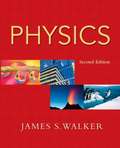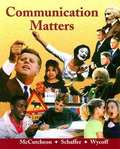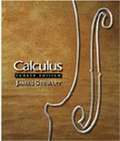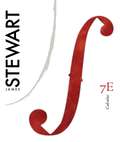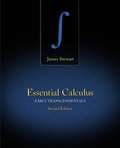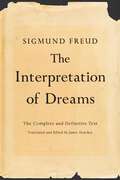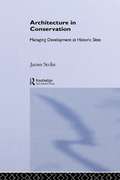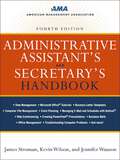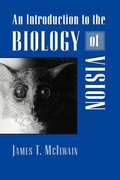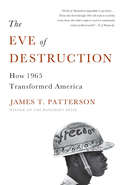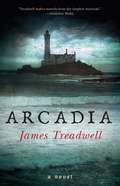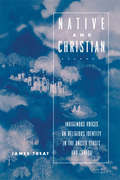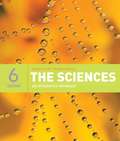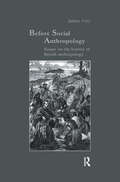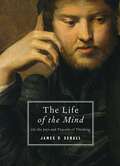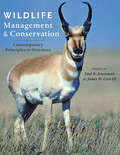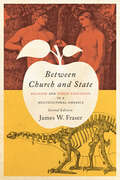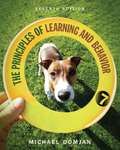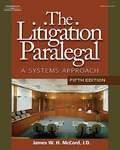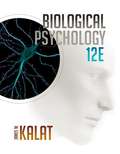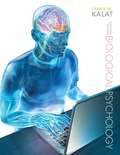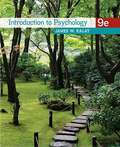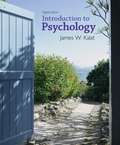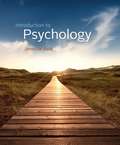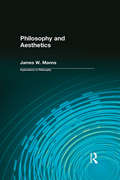- Table View
- List View
Physics (Second Edition)
by James S. WalkerThis introduction to algebra-based physics covers the full spectrum of topics in Mechanics, Thermal Physics, Electromagnetism, Light and Optics, and Modern Physics.
Communication Matters
by James Schaffer Randall Mccutcheon Joseph R. WycoffDescribes how to research, organize, write, and deliver different kinds of speeches and discusses related forms of communication such as debates, oral interpretation, and radio.
Calculus
by James StewartSuccess in your calculus course starts here! James Stewart's CALCULUS texts are world-wide best-sellers for a reason: they are clear, accurate, and filled with relevant, real-world examples. With CALCULUS, Seventh Edition, Stewart conveys not only the utility of calculus to help you develop technical competence, but also gives you an appreciation for the intrinsic beauty of the subject. His patient examples and built-in learning aids will help you build your mathematical confidence and achieve your goals in the course!
Essential Calculus: Early Transcendentals
by James StewartThis book is for instructors who think that most calculus textbooks are too long. In writing the book, James Stewart asked himself: What is essential for a three-semester calculus course for scientists and engineers? ESSENTIAL CALCULUS: EARLY TRANSCENDENTALS, Second Edition, offers a concise approach to teaching calculus that focuses on major concepts, and supports those concepts with precise definitions, patient explanations, and carefully graded problems. The book is only 900 pages--two-thirds the size of Stewart's other calculus texts, and yet it contains almost all of the same topics.
The Interpretation of Dreams: The Complete and Definitive Text
by Sigmund Freud James StracheyWhat are the most common dreams and why do we have them? What does a dream about death mean? What do dreams of swimming, failing, or flying symbolize? First published by Sigmund Freud in 1899, The Interpretation of Dreams considers why we dream and what it means in the larger picture of our psychological lives. Delving into theories of manifest and latent dream content, the special language of dreams, dreams as wish fulfillments, the significance of childhood experiences, and much more, Freud, widely considered the "father of psychoanalysis,” thoroughly and thoughtfully examines dream psychology. Encompassing dozens of case histories and detailed analyses of actual dreams, this landmark text presents Freud’s legendary work as a tool for comprehending our sleeping experiences. Renowned for translating Freud’s German writings into English, James Strachey--with the assistance of Anna Freud--first published this edition in 1953. Incorporating all textual alterations made by Freud over a period of thirty years, it remains the most complete translation of the work in print. Completely redesigned and available for the first time in trade paperback
Architecture in Conservation: Managing Development at Historic Sites (Heritage: Care-preservation-management Ser.)
by James StrikeOne of the problems faced by heritage organizations and museums is adapting old buildings to their needs or building new ones to fit in with historic sites. How exactly do you create a visitor's centre at Stonehenge? The real difficulty lies where the budget is minimal, and the potential damage to the environment or setting enormous. Architecture i
Administrative Assistant's and Secretary's Handbook (Administrative Assistant's And Secretary's Handbook Ser.)
by James Stroman Kevin Wilson Jennifer WausonAn administrative professional’s job requires a diverse range of abilities. From managing schedules, coordinating meetings, and fielding calls to planning events, deciphering legal documents, and creating PowerPoint presentations, today’s administrative assistants are expected to effortlessly and efficiently juggle it all. Professionals looking to improve their performance—and enhance their value to employers—should turn to the fourth edition of Administrative Assistant’s and Secretary’s Handbook. With 250 pages of new or completely revised material, the handbook provides thorough, practical instruction on: Web conferencing • Creating graphics, charts, and presentations • Microsoft Office 2010 • Business math • Managing e-mail and schedules with Outlook • Organizing computer files • Research skills • Time management • Customer service skills • Troubleshooting computer problems • Event planning • and much more. Administrative jobs are constantly changing, but with the latest edition of this best-selling guide, professionals everywhere can stay ahead of the curve.
An Introduction to the Biology of Vision
by James T. McilwainThis textbook is intended for use in a course for undergraduate students in biology, neuroscience or psychology who have had an introductory course on the structure and function of the nervous system. Its primary purpose is to provide a working vocabulary and knowledge of the biology of vision and to acquaint students with the major themes in biological vision research. Part I treats the eye as an image-forming organ and provides an overview of the projections from the retina to key visual structures of the brain. Part II examines the functions of the retina and its central projections in greater detail, building on the introductory material of Part I. Part III treats certain special topics in vision that require this detailed knowledge of the structure and properties of the retina and visual projections.
The Eve of Destruction: How 1965 Transformed America
by James T. PattersonOf all the changes that have swept across America in the past century, perhaps none have been as swift or dramatic as those that transpired in the 1960s. The United States entered the decade still flush with postwar triumphalism, but left it profoundly changed: shaken by a disastrous foreign war and unhinged by domestic social revolutions and countercultural movements that would define the nation''s character, politics, and policies for decades to come. The prevailing understanding of the 1960s traces its powerful shockwaves to 1968, a year of violent protests and tragic assassinations. But in The First Year of the Sixties, esteemed historian James T. Patterson shows that it was actually in 1965 that America truly turned a corner and entered the new, tumultuous era we now know as "The Sixties. " In the early 1960s, America seemed on the cusp of a golden age. Political liberalism, national prosperity, and interracial civil rights activism promised positive change for many Americans. Although the nation had been shocked by the 1962 Cuban Missile Crisis and the 1963 assassination of President Kennedy, America''s fundamental traditions and mores remained intact. It was a time of consensus and optimism, and popular culture reflected this continuity. Young people dressed and behaved almost exactly as they did in the 1950s, and if the music and hairstyles of the British Invasion worried some conservative parents, these concerns were muted. At the beginning of 1965, Americans saw no indication that the new year would be any different. In January, President Johnson proclaimed that the country had "no irreconcilable conflicts. " Initially, events seemed to prove him right. The economy continued to boom, and the overwhelmingly Democratic Congress passed a host of historic liberal legislation, from the Voting Rights Act to Medicare and Medicaid to expansions of federal aid for education and the war on poverty. But Patterson shows that, even amidst these reassuring developments, American unity was unraveling. Turmoil erupted in the American South and overseas in the spring of 1965, with state troopers attacking civil rights demonstrators in Selma, Alabama and American combat troops rushing into Vietnam to protect American interests there. Many black leaders, meanwhile, were becoming disenchanted with nonviolence, and began advocating instead for African-American militancy. That summer, as anti-war protests reached a fever pitch, rioting exploded in the Watts area of Los Angeles; the six days of looting and fires that followed shocked many Americans and cooled their enthusiasm for the president''s civil rights initiatives, which--like his other "Great Society" programs--were also being steadily undermined by the costly and unpopular war in Vietnam. Conservative counterattacks followed, with Republicans like California gubernatorial candidate Ronald Reagan--and even some disillusioned Democrats--criticizing the President for mismanaging the war and expanding the federal government past its manageable limits. As Patterson explains, this growing pessimism permeated every level of society. By the end of 1965 the national mood itself had darkened, as reflected in a new strain of anti-establishment rock music by artists like the Rolling Stones, Bob Dylan, the Grateful Dead, and Jefferson Airplane. Their songs and lyrics differed dramatically from the much more staid recordings of contemporary acts like Frank Sinatra, Julie Andrews, and the Supremes, reflecting an alienation from mainstream American culture shared by an increasing number of young Americans. In The First Year of the Sixties, James T. Patterson traces the transformative events of this critical year, showing how 1965 saw an idealistic and upbeat nation derailed by developments both at home and abroad. An entire generation of Americans--as well as the country''s politics, culture, race relations, and foreign policies--would never be the same.
Arcadia: A Novel (Advent Trilogy Ser. #Bk. 3)
by James Treadwell"Magnificent." --Publishers Weekly (starred review) It's a year and a half after the events of Anarchy--a novel hailed as "bewitchingly perplexing and supernaturally entertaining" (Kirkus Reviews)--and the world is alive with magic in this third astonishingly imaginative novel in the fantasy trilogy that began with Advent.On a tiny archipelago out of sight of the rest of the world lives Rory, a ten-year-old boy. He and his mother and a handful of survivors live an exhausting and precarious existence, entirely isolated. The sea is alive, and angry. Every man Rory can remember has been drowned. Everyone knows he'll be next. One night, for the first time since the world changed and the curse descended, strangers appear on the island. They're on their way to England, seeking a powerful magic ring. And one of them seems to know Rory by sight... Caught up in their quest, Rory enters an England of terrors and marvels, at the heart of which lies a place where journeys unimaginably longer and older than his will reach their end: Pendurra.
Native and Christian: Indigenous Voices on Religious Identity in the United States and Canada
by James TreatNative and Christian is an anthology of essays by indigenous writers in the United States and Canada on the problem of native Christian identity. This anthology documents the emergence of a significant new collective voice on the North American religious landscape. It brings together in one volume articles originally published in a variety of sources (many of them obscure or out-of-print) including religious magazines, scholarly journals, and native periodicals, along with one previously unpublished manuscript.
The Sciences: An Integrated Approach (Sixth Edition)
by James Trefil Robert M. HazenOver 100,000 readers have relied on Trefil to gain a better understanding of physics, chemistry, astronomy, earth sciences, and biology. The book focuses on the great ideas in each field while showing readers how core scientific principles connect to their daily lives. The sixth edition emphasizes important themes and relationships, along with new real world connections. Scientific American has been added to the book along with completely updated examples. The presentation also employs a more visual approach that includes new illustrations and visuals. In addition, new problems help readers answer the big questions in science.
Before Social Anthropology: Essays on the History of British Anthropology (Studies in Anthropology and History)
by James UrryFirst Published in 1993. Routledge is an imprint of Taylor & Francis, an informa company.
The Life of the Mind: On the Joys and Travails of Thinking
by James V. SchallIn The Life of the Mind, Georgetown University&’s James V. Schall takes up the task of reminding us that, as human beings, we naturally take a special delight and pleasure in simply knowing. Because we have not only bodies but also minds, we are built to know what is. In this volume, Schall, author of On the Unseriousness of Human Affairs, among many other volumes of philosophical and political reflection, discusses the various ways of approaching the delight of thinking and the way that this delight begins in seeing and hearing and even in making and walking. We must be attentive to and cultivate the needs of the mind, argues Schall, for it is through our intellect that all that is not ourselves is finally returned to us, allowing us to live in the light of truth.
Wildlife Management and Conservation: Contemporary Principles and Practices (Wildlife Management And Conservation Ser.)
by Paul R. Krausman James W. Cain IIIA definitive textbook for students of wildlife management.Wildlife Management and Conservation presents a clear overview of the management and conservation of animals, their habitats, and how people influence both. The relationship among these three components of wildlife management is explained in chapters written by leading experts and is designed to prepare wildlife students for careers in which they will be charged with maintaining healthy animal populations; finding ways to restore depleted populations while reducing overabundant, introduced, or pest species; and managing relationships among various human stakeholders.Topics covered in this book include• The definitions of wildlife and management• Human dimensions of wildlife management• Animal behavior• Predator–prey relationships • Structured decision making• Issues of scale in wildlife management• Wildlife health• Historical context of wildlife management and conservation• Hunting and trapping• Nongame species• Nutrition ecology• Water management• Climate change• Conservation planning
Between Church and State: Religion and Public Education in a Multicultural America
by James W. FraserA fully updated second edition of this essential look at the continuing tensions between religion and American public schools.Today, the ongoing controversy about the place—or lack of place—of religion in public schools is a burning issue in the United States. Prayer at football games, creationism in the classroom, the teaching of religion and morals, and public funding for private religious schools are just a few of the subjects over which people are skirmishing. In Between Church and State, historian and pastor James W. Fraser shows that these battles have been going on for as long as there have been public schools and argues there has never been any consensus about what the "separation of church and state" means for American society or about the proper relationship between religion and public education.Looking at the difficult question of how private issues of faith can be reconciled with the very public nature of schooling, Fraser’s classic book paints a complex picture of how a multicultural society struggles to take the deep commitments of people of faith into account—including people of many different faiths and no faith. In this fully updated second edition, Fraser tackles the culture wars, adding fresh material on current battles over public funding for private religious schools. He also addresses the development of the long-simmering evolution-creationism debate and explores the tensions surrounding a discussion of religion and the accommodation of an increasingly religiously diverse American student body.Between Church and State includes new scholarship on the role of Roger Williams and William Penn in developing early American conceptions of religious liberty. It traces the modern expansion of Catholic parochial schools and closely examines the passage of the First Amendment, changes in American Indian tribal education, the place of religion in Booker T. Washington and W. E. B. Du Bois’s debates about African American schooling, and the rapid growth of Jewish day schools among a community previously known for its deep commitment to secular public education.
The Principles of Learning and Behavior
by James W. GrauThis learning and behavior textbook provides a comprehensive introduction to the elementary forms of learning that have been the focus of research for much of the 20th century.
The Litigation Paralegal: A Systems Approach Fifth Edition
by James W. H. MccordEducators and students alike will benefit from the clear presentation of material, the emphasis on ethics, the extensive coverage of electronic discovery and filing, as well as features such as the medical guide, numerous checklists, provocative quotations, and a wealth of practical assignments set in the context of one or more litigation cases
Biological Psychology
by James W. KalatDr. James W. Kalat's BIOLOGICAL PSYCHOLOGY is widely used for good reason: an extremely high level of scholarship, a clear writing style with amusing anecdotes, and precise examples. Kalat's goals are to make biological psychology accessible and to convey the excitement of the search for biological explanations of behavior, and he delivers. Updated with new topics, examples, and recent research findings, the new 12th edition continues this book's tradition of quality.
Biological Psychology (Eleventh Edition)
by James W. KalatThe most widely used text in its course area, Dr. James W. Kalat's BIOLOGICAL PSYCHOLOGY appeals to students and instructors alike. Throughout all eleven editions, the goal has been to make biological psychology accessible to psychology students, not just to biology majors and pre-meds. The goal has also been to convey the excitement of the search for biological explanations of behavior. Kalat believes that biological psychology is "the most interesting topic in the world," and this text convinces many students--and perhaps you, too--with its clear writing style, amusing anecdotes, and intriguing examples. A media-rich, highly interactive online eBook integrates the text with videos, animations, and an online bio-lab component, making it easier for you to learn.
Introduction To Psychology 9th Ed
by James W. KalatJames Kalat's best-selling INTRODUCTION TO PSYCHOLOGY does far more than cover major theories and studies; it encourages you to question the information and ask yourself, "How was this conclusion reached?" and "Does the evidence really support it?" In this student-praised text, Kalat challenges your preconceptions about psychology to help you become a more informed consumer of information not only during your college experience but also as you venture into your post-college life. With his humorous writing style and hands-on "Try It Yourself" exercises, Kalat puts you at ease and gets you involved with what you are studying so that you can succeed in your course.
Introduction to Psychology (8th edition)
by James W. KalatFocusing on one type of behavior at a time, this textbook examines the roles biology, learning experiences, and social influences play in human intelligence, memory, perception, states of consciousness, cognition, motivation, and personality. The eighth edition updates references and adds sections on synesthesia, procrastination, and decision making. Annotation ©2007 Book News, Inc., Portland, OR (booknews.com)
Introduction to Psychology (Tenth Edition)
by James W. KalatJames Kalat's best-selling INTRODUCTION TO PSYCHOLOGY does far more than cover major theories and studies; it encourages you to question the information and ask yourself, "How was this conclusion reached?" and "Does the evidence really support it?" In this student-praised text, Kalat challenges your preconceptions about psychology to help you become a more informed consumer of information not only during your college experience but also as you venture into your post-college life. With his humorous writing style and hands-on "Try It Yourself" exercises, Kalat puts you at ease and gets you involved with what you are studying so that you can succeed in your course.
Philosophy and Aesthetics: Aesthetics And Metaphysics (Brill's Studies In Intellectual History #Vol. 45)
by James W. MannsJames Manns presents a readable and entertaining examination of the most serious questions posed by the arts and our relation to them. In a clear and engaging fashion, he explores the central issues in aesthetics: aesthetic judgment, the nature and role of criticism, the elusiveness of the concept of art, and communication through art, and he critically (but sympathetically) considers that principal theories of art that focus on expression, form, and representation. Through the use of extensive, entertaining, and current examples (including film), Manns conveys the solid basics relating to the history and development of aesthetic theories, tries out these various theories against the art of the last half century, then outlines his own view revolving around the artist's intention and the act of communication.
